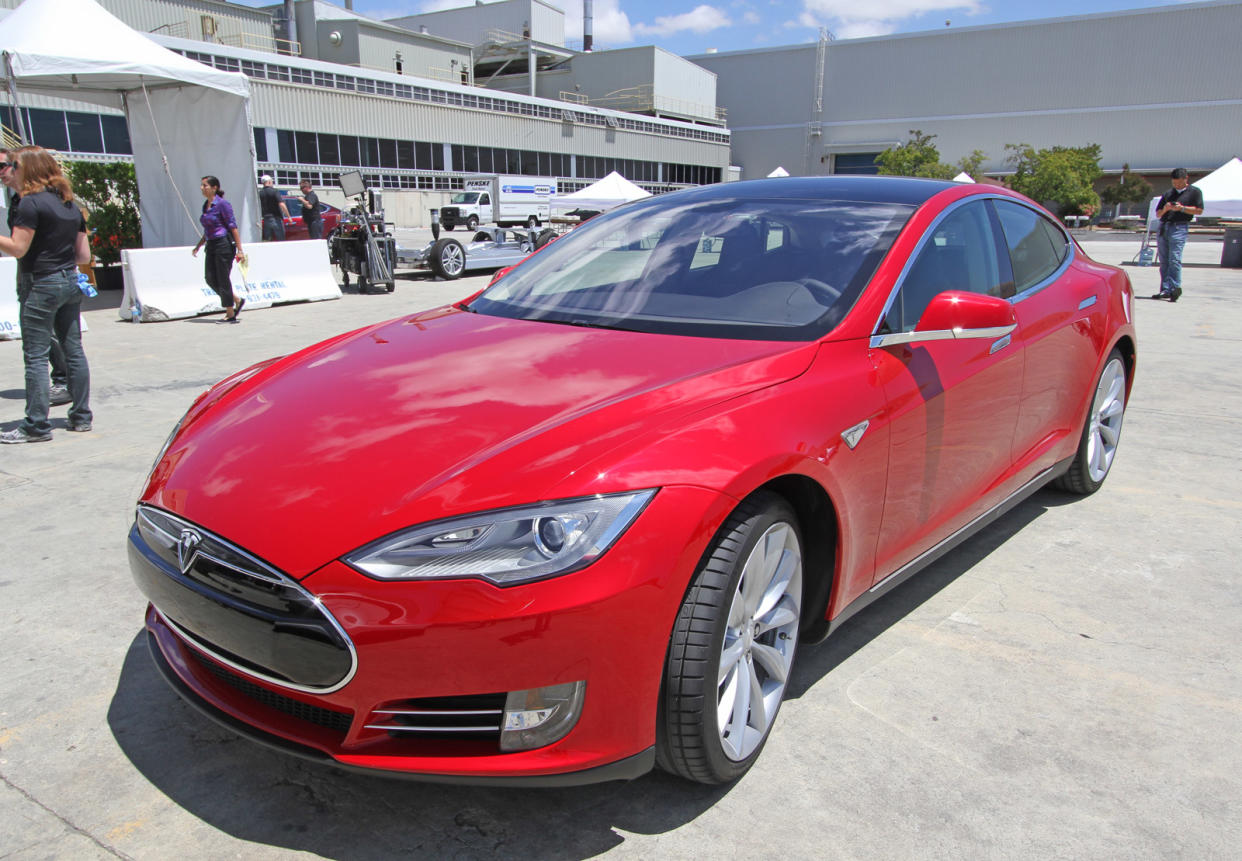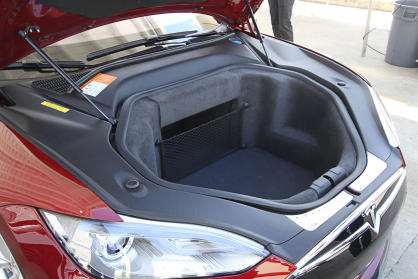 The Lookout
The LookoutTesla Model S: First drive of the electric sedan that will change the world or die trying

Of all the new cars unveiled this year, none will be as hotly anticipated as the Model S from Tesla Motors (TSLA), a luxury sedan doubling as a brash, billion-dollar bet that the era of the electric car has arrived. As the first journalist to test-drive one, I can report the Tesla Model S successfully challenges a century of assumptions about what a great car can be.
The Model S launching today from a Fremont, Calif., factory represents four years of work by Tesla engineers, fueled by $465 million in U.S. government loans and $220 million in Wall Street money (along with $50 million and the factory itself, which was originally built as a joint venture between GM and Toyota). Elon Musk, Tesla's co-founder and CEO, has vowed to make the Model S the best car in the world, and hopes to sell 20,000 a year -- at prices between $54,700 up to $105,400 -- once the factory ramps to full speed.
The last successful American startup automaker was Chrysler, founded 87 years ago. Every genius, huckster, and combination thereof who's tried since has been ground into a fine powder by massive up-front costs combined with meager profits and ruthless competition. Musk, a South African-born entrepreneur who's also founded the SpaceX rocket company, says he believes in electric cars as the necessary future of driving, and only someone with true fervor would put so much of their life into this machinery.
[Slideshow: First look at the Tesla Model S]
While the Tesla Roadster was basically a battery-operated Lotus with an electric motor, Tesla designed the Model S as an EV from the start. The all-aluminum car they've built stands as a sleek luxury sedan, a little larger than a BMW 5-Series, and from the outside there's no indication that it's electric (even the charge port is hidden behind a side reflector in the rear taillight assembly). That's by design — Tesla designer Franz von Holzhausen wanted a car that wouldn't scare buyers away. But the hints of revolution within the Model S begin with the door handles, which slide out of the body with a motorized purr when you touch them, then retract once you're behind the wheel — the kind of detail perfect for leaving valet parkers slack jawed.
I've driven a score of electric cars like the Nissan Leaf, along with serial hybrids like the Chevy Volt and Tesla's start-up competitor of sorts, the Fisker Karma, so I had some idea what to expect when Musk handed me the sleek key fob for an hour-long stint. I was wrong: The Tesla Model S drives like none of them, or any gas-powered vehicle ever built.
GEORGE JETSON, YOUR RIDE HAS ARRIVED
The first sight that greets you behind the wheel is a 17-inch touchscreen that fills the dash, eliminating almost all the buttons and knobs that clutter up most car interiors, one of the ways in which Elon Musk compares with Steve Jobs. Fed by a cellular data connection, the screen divides itself into zones for different functions — keeping the music player separate from the climate controls and the Google Maps navigation, for instance — and responds as quickly as an iPad to inputs. The graphics carry enough heft to be seen in your peripheral vision, but there will be questions about whether Tesla's reducing distractions or super-sizing them.
On the road, the Model S rewires what you expect when your foot touches the pedals. Unlike gas engines, electric cars generate their maximum power at start -- and no electric car has ever had as much power as the Model S, whose Performance edition is good for 417 hp. The zero-to-60 mph run ticks by in an impressive 4.4 seconds (5.9 seconds for the 362 hp edition), and the thrust from the instant you mash the accelerator pushes back like Alec Baldwin at a paparazzi convention.
At the other end, the Model S tries to recapture as much energy as possible from the car's motion by letting the wheels recharge the batteries. In regular driving, that means the Model S immediately begins to slow once you take your foot off the pedal, at a rate a few ticks greater than normal coasting. It's not enough to stop the car entirely in normal driving, and Tesla has made the tip-in point where the mechanical brakes latch on imperceptible, but it does mean that cruise control becomes a necessity on long drives.
"RANGE ANXIETY" ELIMINATED
The fact that the Model S can even do long drives — up to 285 miles in the edition launching today — comes thanks to its battery pack, some 7,000 AA-sized lithium-ion cells bolted into panels under the passenger compartment, holding 85 kWh of energy in the top-end edition, or about as much energy as a typical American house uses in three days. Those batteries make the Model S weigh some 4,400 lbs., but Tesla has turned that mass into an advantage.
By keeping a vehicle's center of gravity low, it's easier to take a curve (think Barry Sanders). For instance, the Subaru BRZ, equipped with a low-mounted boxer engine, is hailed for its 18-inch center of gravity, which bests those of Ferraris and Porsches. The Model S has a center of gravity just 16 inches high, and around a corner there's barely any sense of body roll — just the purest expression of curvilinear motion since the electricity car of "Automan."
The big Tesla's chassis points toward comfort rather than track; while the steering is adjustable, even in sport more it's slightly looser than a comparable BMW 640i Gran Coupe. While the air suspension's height is adjustable, ride stiffness isn't in most models. Traction control is defeatable, but for the purposes of our first drive we left it on and could not get the rear wheels to break loose to add oversteer; without traction control, the motors would likely spin the tires to vulcanized dust.
POWER, PERFORMANCE, AND PRACTICALITY
Without the engine, transmission, and fuel tanks needed for a normal car, the Model S stows a freakish amount of cargo space. The front hood conceals a trunk good for 8 cu. ft. of cargo room; the rear hatch adds another 27 cu. ft., and if you would rather haul small people, Tesla offers a pair of rear-facing jump seats for children behind the second row (and which stow beneath the cargo floor when not in use). Rear headroom is cramped by the sloping roof, so we strongly recommend opting for the panoramic roof to add a precious inch. The downside to the interior is that it can seem so cool it's cold, focusing on the touch screen while missing some of the grace notes other luxury brands offer.
The revelation of what Tesla has accomplished sunk in when I returned to a gas-powered vehicle. Other luxury cars will keep pace with the Tesla, but after driving the Model S, suddenly you notice the lag between accelerator and power, the exhaust noise, all the energy necessary to keep those parts hurtling forward. It makes a fossil fuel-powered car seem to be working so much harder than necessary. Which is the point.
Even a luxury car like the Model S remains one of the larger purchases its customers will make, and the Model S carries a long list of risks, from the mundane to the serious. The Model S range will still depend on how you drive it, and needs a plug more powerful than a standard household outlet for any sizable amount of energy in under a few hours. Tesla has sold a total of 2,150 cars to date; it's never dealt with thousands of customers, nor run a high-volume factory. The launch of the Fisker Karma has been plagued by software bugs and battery recalls, and while Musk says the Model S passed all crash tests with flying colors, Tesla's customers -- more than 10,000 of whom have already paid $5,000 deposits -- will be the test bed of a new company with a new model in what's essentially a new factory.
Yet if Tesla fails, it won't be because the Model S misfired. It's a car that runs from the blocks with the Cadillac CTS-V, Mercedes-Benz E-Class, and Maseratis of the world, and it will be far easier for Tesla to close any gaps with the competition than vice versa. From behind the wheel of the Tesla Model S, you feel you're driving the future, instead of burning increasingly limited gallons of the past.
- Justin Hyde


